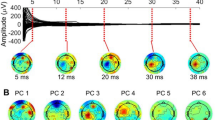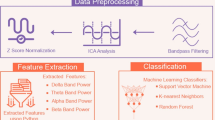Summary
Linear filter analysis was used to detect the occurrence of neuroelectric signals in associated noisy background electrical activity by matching a signal template against incoming neuroelectric data. Bach signal to be detected in the neuroelectric data consisted of a gross potential change recorded at the coronal — precruciate cortex of a cat, evoked by an auditory conditional stimulus, and related to the production of a conditioned facial movement. Detection of the occurrence of the signal corresponded closely to detection of the ensuing movement.
The operation of the matched filter on the signals in noise was studied for different threshold levels of detection. Threshold settings were selected to maximize successful detections and to minimize false alarms. The results of our experimental detections agreed closely with predicted, theoretical detection levels derived from Wiener's models of optimum detection of signals in additive noise. Levels of detection were found to depend upon the signal to noise ratios and frequency spectra of the analyzed data and could be predicted a priori from a knowledge of the latter on the basis of Wiener's theory. The ability to predict optimum detection levels, by the linear filter method, of cortical electrical signals related to the production of movements may provide a basis for evaluating the merit of such signals in the design of prosthetic devices for motor control.
Similar content being viewed by others
References
Communication Biophysics Group of Research Laboratory of Electronics and Siebert, W.M.: Processing neuroelectric data. Technical Report 351, Research Laboratory of Electronics. Massachusetts: Institute of Technology 1959.
Davenport, W.B., Jr., Root, W.L.: An Introduction to the Theory of Random Signals and Noise. New York: McGraw-Hill 1958.
Feller, W.: An Introduction to Probability Theory and its Application, Vol. I (2nd ed.). New York: John Wiley 1965.
Fetz, E.E.: Operant conditioning of cortical unit activity. Science 163, 955–958 (1969).
Fox, S.S., Rudell, A.P.: Operant controlled neural event: Functional independence in behavioral coding by early and late components of visual cortical evoked response in cats. J. Neurophysiol. 33, 548–561 (1970).
Frank, K.: Use of neural signals to control external device. Neurosci. Res. Prog. Bull. 9, 113–118 (1971).
Friedman, D.H.: Detection of Signal by Template Matching. Baltimore: The Johns Hopkins Press 1968.
Harris, E.K., Woody, C.D.: Use of an adaptive filter to characterize signal-noise relationships. Computers and Biomed. Res. 2, 242–273 (1969).
Heistrom, C.W.: Statistical Theory of Signal Detection. New York: Pergamon Press 1988.
Jakowatz, C.V., Shuey, R.L., White, G.H.: Adaptive wave form recognition. In: Information Theory, Fourth London Symposium. Ed. by C. Cherry. London: Butterworths 1961.
Lee, Y.W.: Statistical Theory of Communication. New York: John Wiley 1960.
Van Trees, H.L.: Detection, Estimation and Modulation Theory, Part I. New York: John Wiley 1968.
Vaughan, H.G., Jr., Costa, L.D., Ritter, W.: Topography of the human motor potential. E.E.G. clin. Neurophysiol. 25, 1–10 (1968).
Wiener, N.: The Fourier Integral and Certain of its Applications. New York: Cambridge Univ. Press 1933.
Woody, C.D.: Characterization of an adaptive filter for the analysis of variable latency neuroelectric signals. Med. biol. Engng. 5, 539–553 (1967).
—: Conditioned eye blink: Gross potential activity at coronal — precruciate cortex of the cat. J. Neurophysiol. 33, 838–850 (1970).
—, Brozek, G.: Gross potential from facial nucleus of cat as an index of neural activity in response to glabella tap. J. Neurophysiol. 32, 704–716 (1969).
—, Engel, J., Jr.: Changes in unit activity and thresholds to electrical microstimulation at coronal — pericruciate cortex of cat with classical conditioning of different facial movements. J. Neurophysiol. 35, 230–241 (1972).
Zadeh, L.A., Ragazzini, R.: Optimum filters for detection of signals in noice. Proc. IRE. 40, 1223–1231 (1952).
Author information
Authors and Affiliations
Additional information
Visiting scientist from Department of Electrical Engineering, Aria Mehr University, Tehran, Iran.
Rights and permissions
About this article
Cite this article
Woody, C.D., Nahvi, M.J. Application of optimum linear filter theory to the detection of cortical signals preceding facial movement in cat. Exp Brain Res 16, 455–465 (1973). https://doi.org/10.1007/BF00234472
Received:
Published:
Issue Date:
DOI: https://doi.org/10.1007/BF00234472




